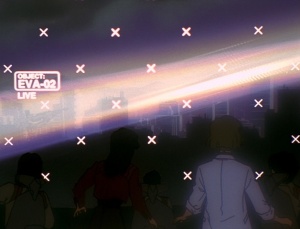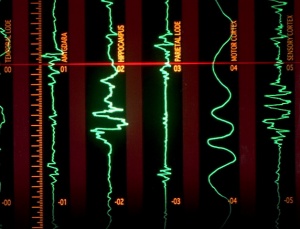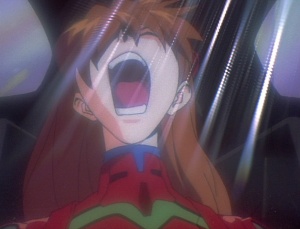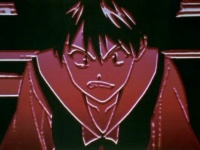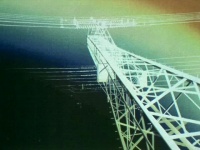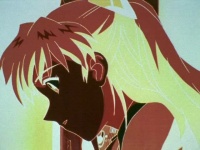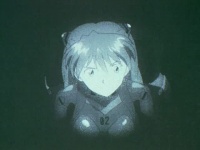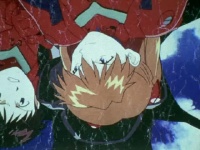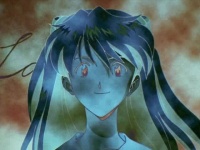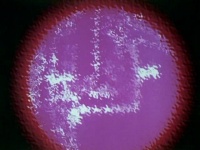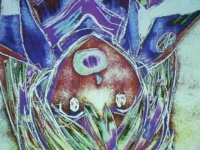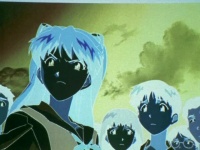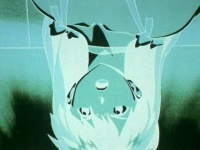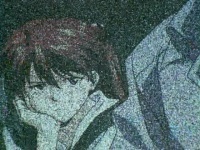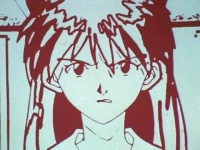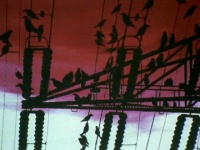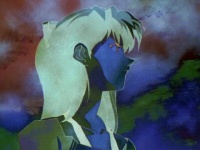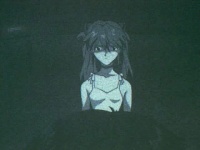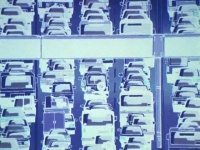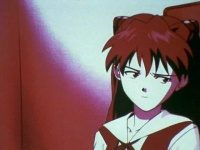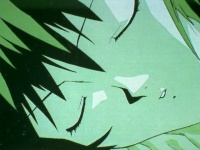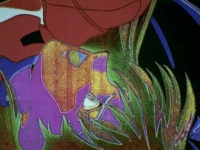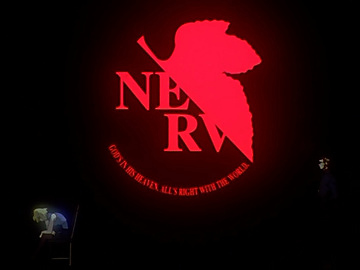tr:Teori ve Analiz: Evangelion'da Film Montajı Teorisi: Difference between revisions
Mbselvitopu (talk | contribs) |
Mbselvitopu (talk | contribs) No edit summary |
||
| Line 87: | Line 87: | ||
:Ardından, gerçek bir güvenlik açığımız var. Asuka, Shinji'nin yatağında uyurken annesi için ağlıyor. Yine anneye karşı diğer önemli temanın keşfine dönüyoruz. Bir sonraki sahne, Asuka'nın daha açık bir çapkınlığını göstermekte. Yine, bu, erkek bakışı için kendini cinselleştiren, daha çok dikkat çekme davranışıdır. | :Ardından, gerçek bir güvenlik açığımız var. Asuka, Shinji'nin yatağında uyurken annesi için ağlıyor. Yine anneye karşı diğer önemli temanın keşfine dönüyoruz. Bir sonraki sahne, Asuka'nın daha açık bir çapkınlığını göstermekte. Yine, bu, erkek bakışı için kendini cinselleştiren, daha çok dikkat çekme davranışıdır. | ||
: | :Son olarak, bu alt montajda yapılan kilit açıklama şudur: Anime boyunca, 22. bölümde Shinji'ye karşı nefret itirafını aktif olarak reddetti. Shinji'nin uygun şekilde yanıt verememesine olumsuz tepki veriyor, ancak yine de onu istiyor. | ||
* | *Çekim 17-23: Türlerin sonucu. "Aptal mısın?" yazan bir ara başlık görüyoruz. Neredeyse her zaman Shinji'ye yönelik olan bu alıntı, özellikle doğrudur. "Aptal mısın," diye soruyor, "bana cevap vermeyi reddediyorsun?!". Bir sonraki çekimde gösterilen Shinji'nin yatağına yatmaya kadar gittiği ve bundan sonraki çekimde gösterilen başka bir çocukla randevusunu iptal ettiği için haklı olarak kızgın. Bir sonraki plan "aptal mısın teması" üzerine kuruludur, neredeyse tamamen suçlayıcı bir çekimdir ve 22. bölümde Shinji'ye karşı Shinji'ye olan nefretini işaret eder. | ||
:In the final three shots, we will finally reach the conclusion, the climax, the major statement that this montage has been building up to. We see a misty scene, so what we can imply is that there is a truth needing to be unveiled, a secret code needing to be cracked: What does Asuka want? In what seems to be a phallic allegory, the answer is simply: Shinji. And with the final shot of her piloting flipped, one can only assume that this realization has turned all of her facades, defense mechanisms, and her justification for existence completely upside-down. | :In the final three shots, we will finally reach the conclusion, the climax, the major statement that this montage has been building up to. We see a misty scene, so what we can imply is that there is a truth needing to be unveiled, a secret code needing to be cracked: What does Asuka want? In what seems to be a phallic allegory, the answer is simply: Shinji. And with the final shot of her piloting flipped, one can only assume that this realization has turned all of her facades, defense mechanisms, and her justification for existence completely upside-down. | ||
Revision as of 09:47, 30 May 2021

|
"Making something... Nurturing something is really great. You can see and learn so many things from the process." |
Evangelion'a genellikle anlatı olarak bakılır, ancak onu sinematografinin teknik düzeyinde ve özellikle bu denemede montaj düzeyinde de değerlendirmek gerekir. Animede birkaç montaj dizisi var, ancak bunların en dikkat çekicileri 14, 22 ve 26'. bölümlerde tezahür ediyor. Başkaları da olsa, bu üç bölümdeki montaj sekansları, bu kritik makalenin ilk baskısında incelenecek.
Bu sayfa Kullanıcı: Ran1'in sayfasından uyarlanıyor, çoğunlukla orijinal yazardan alınan materyallerle. Bunu tartışmak isterseniz lütfen ona başvurun.
Klasik Montaj Teorisine Giriş
Montaj teorisi, Sovyet film yapımcısı/kuramcısı Sergei Eisenstein tarafından 1922'de ufuk açıcı sinema incelemesi Film Biçimine Diyalektik Bir Yaklaşım ile geliştirildi. Bu inceleme, özet olarak, teoriyi şu terimlerle sundu:
- 1. Montajdaki imgeler, ayrı kimlikler olarak var olmanın apaçık nedeni ile orada değildir. Montaj dizisinin kilit yönü, görüntülerin hepsinin birbirine bağlı olmasıdır. Her görüntünün anlamı, önceki ve ardışık görüntüler tarafından inşa edilir ve üzerine inşa edilir.
- 2. Eisenstein'a göre, montaj teorisi “sinemanın özgül problemini”, ortam özgüllüğünü çözdü.
- 3. Montaj özünde, önceki iki görüntüden eksik olan alt metnin birbiriyle “çarpıştırıldığı” ve montajın sonunda daha yeni, tam bir anlam sunduğu “görüntüler arasındaki bir çatışma”dır.
Bu teorinin Evangelion'daki bir uygulaması şu çekim dizisi olabilir:
Anno bu tekniklerde ne kadar usta?
Bu temel yönleri göz önünde bulundurarak, Anno'nun Eisenstein'ın teorik makalelerinden herhangi biriyle karşılaşıp karşılaşmadığının şu anda belirsiz olduğu bilinmelidir. Herhangi bir noktada iyi film ya da animasyon öğrencisi olmalı, çünkü teorileri modern sinemanın gelişimi için son derece önemliydi, ancak Anno'nun iyi bir film öğrencisi olarak statüsünün bir soru meselesi olduğu anlaşılmalıdır; bir başka önemli montaj teorisyeni olan Jean Luc Godard'a aşina olduğunu kabul ettiği düşünülebilir ama Godard'ın tekniklerini benzer bir şekilde kullanan birkaç Japon film yapımcısına da aşina olmuştur.
Bununla birlikte, montaj ve arkasındaki teori, evrensel film yapım diline az çok özümsenmiştir. Anno'nun konuya aşinalığı hâlâ söz konusu olduğu için bu montaj teorilerinin alakasız olduğunu söylemek gerekirse, büyük ihtimalle sadece bir tane yapabilmekle bu konuda bilgi sahibi olduğu söylenebilir.
22. Bölüm
En dikkat çekici montaj sekansları, Asuka'nın en derin, en karanlık anılarının yüzeye çıkarıldığı ve güvensizliklerinin daha da artmasına sebebiyet veren "zihin ihlali" sahnelerinde sunulanlardır. Zorla iç gözlemi doruk noktasına ulaştığında, izleyiciye kelimenin tam anlamıyla Asuka'nın tam bir yapısökümü sunulur. Önümüze serilmiş düşüncelerini, arzularını ve duygularını görüyoruz ve Asuka'nın aşağı doğru sarmalının başladığını, Öteki'yi reddetmesinin başladığını gördüğümüz bir noktaya ulaşıyoruz, en önemlisi üç varlıkta tezahür ediyor: Annesi, Kaji ve Shinji.
İşte bu zihin ihlali montajlarının son hali:
| Montaj Sırası | |||
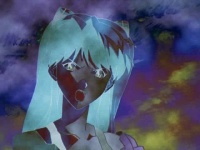 |
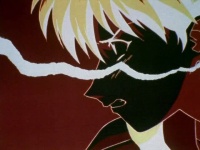 |
 |
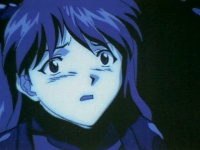
|
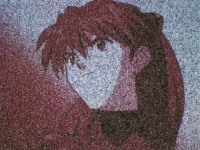 |
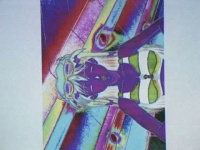 |
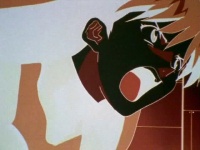 |
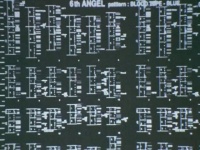
|
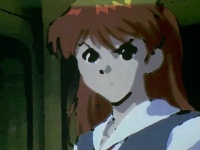 |
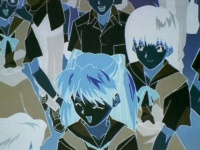 |
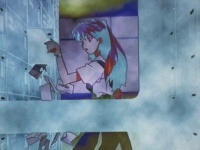 |
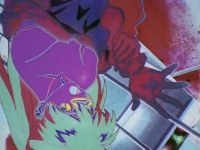
|
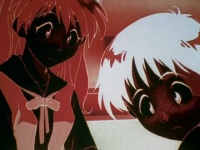 |
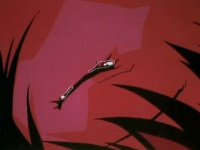 |
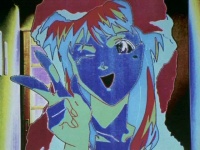 |
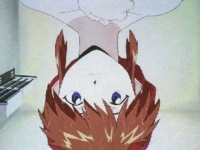
|
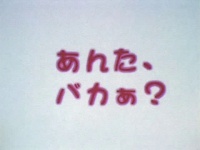 |
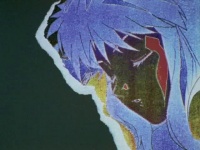 |
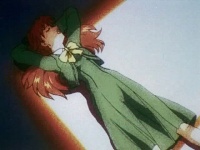 |
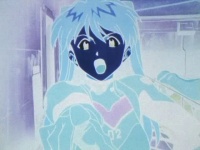
|
 |
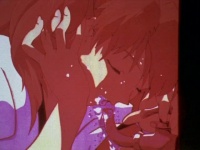 |
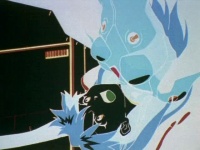 |
|
|
22. Bölümden Kesitler
| |||
| Parlayan Montaj Sırası 3 | |||
 |
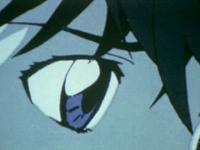 |
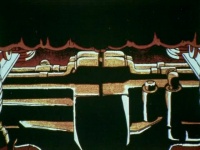 |
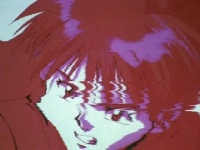
|
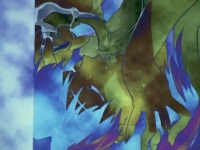 |
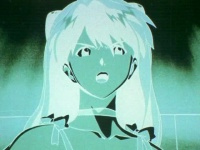 |
 |
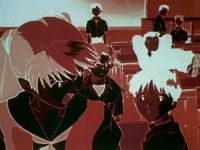
|
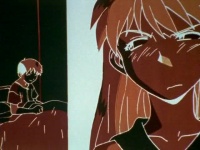 |
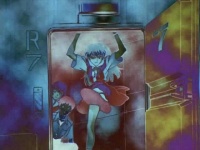 |
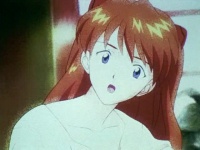 |
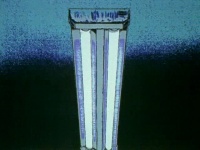
|
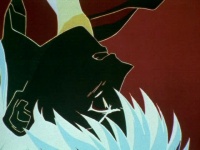 |
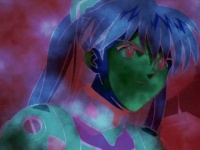 |
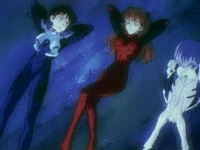 |
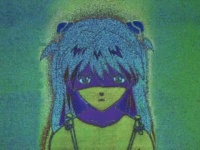
|
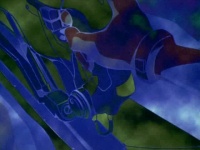 |
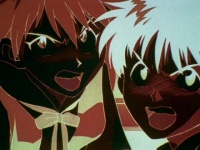 |
 |

|
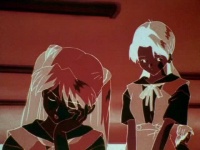 |
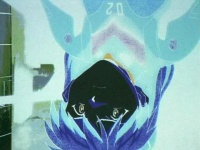 |
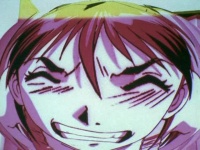 |
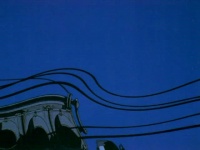
|
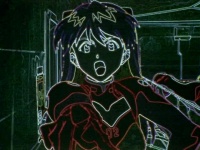 |
|||
|
"22. Bölümden Kesitler"
SHOTS 22-25: But the only way she can maintain this control, it seems, is by making others feel inferior, thus driving them away from her. With no one to control, she is no one. Normally, being this terrible to people, being this commanding, would be anathema to most, but the next shot of Asuka looking on in terror is inverted -- revealing that she is not terrified at her own mental creation, but, as the next shot proves, thrilled, insanely, maddeningly happy about it. This, amplified by the the fish-eye lens, and the following distorted shot, seems to show that Asuka is indeed twisted. And if that was not enough, the montage ends with the "accusative Asuka", effectively saying: "THIS IS YOU." | |||
It is apparent in the context of the montages as well, even the mindrape itself, Asuka is continually placed in positions of weakness. This is evidenced by the "Arael avatar" standing over the fetal-position, naked Asuka, and the "one of many" crowd scene. More on this later, because I am awaiting feedback.
- For differing opinions and discussions about these images, please take a look at this thread
Subverting Wide-Shot stereotypes in Episode 24 of Neon Genesis Evangelion
There is a reasonable adage about the use of the wide or extreme-wide shot in anime series: they are used to save money. With the audience lacking the ability to see the small mouth movements, the animators are able to save frames, and save funds on the production budget. However, amongst fans of a more visceral type, these shots can often seem “lazy” at best, or seemingly a forewarning of a rapidly failing production.
Evangelion was no stranger to these production troubles-- the ship was sinking fast around the time that the last five or so episodes were made. But that being said, these wide shots do not seem to fit the usual “lazy” stereotype that seems to fit so well on the mantle of other anime series that were made with much less directorial care than Evangelion. In fact, in a way startling similar to other media that have used the wide shot, these compositions often give the impression of a “painting” rather than simply a frame of animation.
Following Eisenstein's memorable words that “cinema is a synthesis between art and industry”, there is no reason why the “budget-saving” wide shots in Evangelion can't be artistic. With the help of some sub textual readings into the wide shots on both a narrative and technical level, this essay hopes to present that Evangelion's wide shots are indeed a manifestation of Eisenstein's synthesis.
For the sake of reference, the following wide shots will be used for the sake of this argument:
| Episode 24 Wide Shots | |||
 |
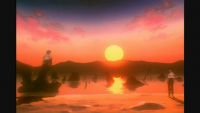 |
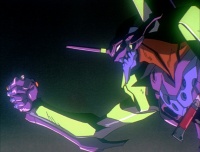 |
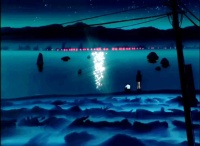
|
|
"Episode 24 Shots" Wide shots used for argument | |||
1.This shot is manifold in dichotomy. First we have what is the obvious: Ritsuko mourning the loss of her cat, and Gendo angry over the loss of the dummy system. But what we have here goes a little deeper than that: What we see now is a Ritsuko who has lost all love for her work, and a Gendo who is working for his love. This shot is a manifestation of the things that it cost the two of them: Ritsuko has lost the things that gave her life justification, Gendo has lost his “soul” and empathy in the process of executing his plan for instrumentality.
2.What goes even deeper is the symbol that sits in the middle of the two of them: a glowing symbol of NERV. What we can see here is the organization and symbol that brought the two of them together, and then drove the two apart. Unlike the previous image where the composition isn't as important as the words being spoken, here we have an image of the very essence of their relationship. For Gendo, NERV is a tool to retrieve his wife. Thus, for the most part he treats those who are a part of it like tools. His emotional detachment to many of the characters is quite obvious throughout the series. For Ritsuko, however, NERV is the justification for her being, what makes Ritsuko Ritsuko is NERV itself, and she treats it very seriously. A classic “conflict of interests” manifested through the organization itself is brilliantly played in this scene through both words and visuals.
1.This shot is manifold in dichotomy. First we have what is the obvious: Ritsuko mourning the loss of her cat, and Gendo angry over the loss of the dummy system. But what we have here goes a little deeper than that: What we see now is a Ritsuko who has lost all love for her work, and a Gendo who is working for his love. This shot is a manifestation of the things that it cost the two of them: Ritsuko has lost the things that gave her life justification, Gendo has lost his “soul” and empathy in the process of executing his plan for instrumentality.
2.What goes even deeper is the symbol that sits in the middle of the two of them: a glowing symbol of NERV. What we can see here is the organization and symbol that brought the two of them together, and then drove the two apart. Unlike the previous image where the composition isn't as important as the words being spoken, here we have an image of the very essence of their relationship. For Gendo, NERV is a tool to retrieve his wife. Thus, for the most part he treats those who are a part of it like tools. His emotional detachment to many of the characters is quite obvious throughout the series. For Ritsuko, however, NERV is the justification for her being, what makes Ritsuko Ritsuko is NERV itself, and she treats it very seriously. A classic “conflict of interests” manifested through the organization itself is brilliantly played in this scene through both words and visuals.
1.This shot is manifold in dichotomy. First we have what is the obvious: Ritsuko mourning the loss of her cat, and Gendo angry over the loss of the dummy system. But what we have here goes a little deeper than that: What we see now is a Ritsuko who has lost all love for her work, and a Gendo who is working for his love. This shot is a manifestation of the things that it cost the two of them: Ritsuko has lost the things that gave her life justification, Gendo has lost his “soul” and empathy in the process of executing his plan for instrumentality.
2.What goes even deeper is the symbol that sits in the middle of the two of them: a glowing symbol of NERV. What we can see here is the organization and symbol that brought the two of them together, and then drove the two apart. Unlike the previous image where the composition isn't as important as the words being spoken, here we have an image of the very essence of their relationship. For Gendo, NERV is a tool to retrieve his wife. Thus, for the most part he treats those who are a part of it like tools. His emotional detachment to many of the characters is quite obvious throughout the series. For Ritsuko, however, NERV is the justification for her being, what makes Ritsuko Ritsuko is NERV itself, and she treats it very seriously. A classic “conflict of interests” manifested through the organization itself is brilliantly played in this scene through both words and visuals.
| Episode 24 Wide Shots | |||
 |
 |
 |

|
|
"Episode 24 Shots" Wide shots used for argument | |||
